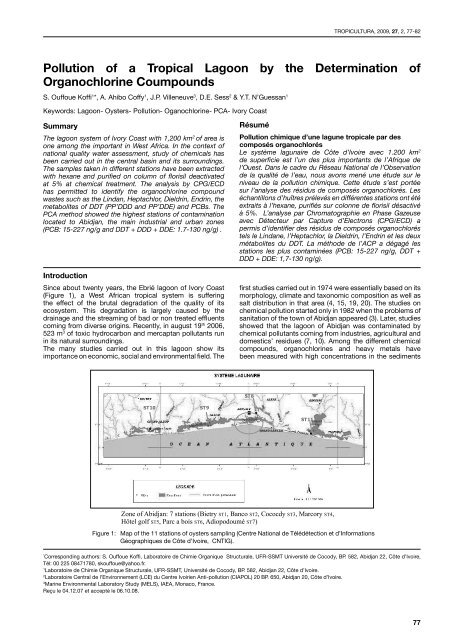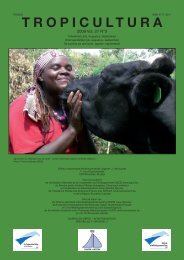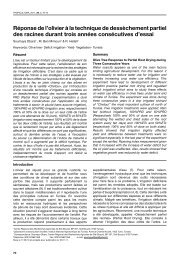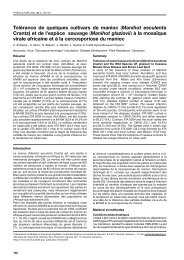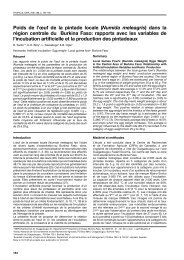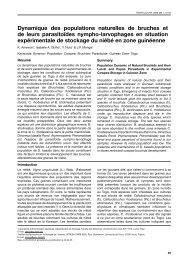Fascicule entier - Tropicultura
Fascicule entier - Tropicultura
Fascicule entier - Tropicultura
Create successful ePaper yourself
Turn your PDF publications into a flip-book with our unique Google optimized e-Paper software.
Summary<br />
The lagoon system of Ivory Coast with 1,200 km 2 of area is<br />
one among the important in West Africa. In the context of<br />
national quality water assessment, study of chemicals has<br />
been carried out in the central basin and its surroundings.<br />
The samples taken in different stations have been extracted<br />
with hexane and purified on column of florisil deactivated<br />
at 5% at chemical treatment. The analysis by CPG/ECD<br />
has permitted to identify the organochlorine compound<br />
wastes such as the Lindan, Heptachlor, Dieldrin, Endrin, the<br />
metabolites of DDT (PP’DDD and PP’DDE) and PCBs. The<br />
PCA method showed the highest stations of contamination<br />
located to Abidjan, the main industrial and urban zones<br />
(PCB: 15-227 ng/g and DDT + DDD + DDE: 1.7-130 ng/g) .<br />
ST10<br />
ST9<br />
Zone of Hôtel Abidjan golf st5, : 7 Parc stations a bois st6, (Bietry Adiopodoumé ST1, Banco st7)<br />
ST2, Cococdy ST3, Marcory<br />
ST4,Hôtel golf. ST5 Parc a bois ST6, Adiopodoumé ST7)<br />
Figure 1: Map of the 11 stations of oysters sampling (Centre National de Télédétection et d’Informations<br />
Géographiques de Côte d’Ivoire, CNTIG).<br />
ST8<br />
ST11<br />
TROPICULTURA, 2009, 27, 2, 77-82<br />
Pollution of a Tropical Lagoon by the Determination of<br />
Organochlorine Coumpounds<br />
S. Ouffoue Koffi 1 *, A. Ahibo Coffy 1 , J.P. Villeneuve 3 , D.E. Sess 2 & Y.T. N’Guessan 1<br />
Keywords: Lagoon- Oysters- Pollution- Oganochlorine- PCA- Ivory Coast<br />
Introduction<br />
Since about twenty years, the Ebrié lagoon of Ivory Coast<br />
(Figure 1), a West African tropical system is suffering<br />
the effect of the brutal degradation of the quality of its<br />
ecosystem. This degradation is largely caused by the<br />
drainage and the streaming of bad or non treated effluents<br />
coming from diverse origins. Recently, in august 19 th 2006,<br />
523 m 3 of toxic hydrocarbon and mercaptan pollutants run<br />
in its natural surroundings.<br />
The many studies carried out in this lagoon show its<br />
importance on economic, social and environmental field. The<br />
* Corresponding authors: S. Ouffoue Koffi, Laboratoire de Chimie Organique Structurale, UFR-SSMT Université de Cocody, BP. 582, Abidjan 22, Côte d’Ivoire,<br />
Tél: 00 225 08471780, skouffoue@yahoo.fr.<br />
1Laboratoire de Chimie Organique Structurale, UFR-SSMT, Université de Cocody, BP. 582, Abidjan 22, Côte d’Ivoire.<br />
2Laboratoire Central de l’Environnement (LCE) du Centre Ivoirien Anti-pollution (CIAPOL) 20 BP. 650, Abidjan 20, Côte d’Ivoire.<br />
3Marine Environmental Laboratory Study (MELS), IAEA, Monaco, France.<br />
Reçu le 04.12.07 et accepté le 06.10.08.<br />
Résumé<br />
Pollution chimique d’une lagune tropicale par des<br />
composés organochlorés<br />
Le système lagunaire de Côte d’Ivoire avec 1.200 km 2<br />
de superficie est l’un des plus importants de l’Afrique de<br />
l’Ouest. Dans le cadre du Réseau National de l’Observation<br />
de la qualité de l’eau, nous avons mené une étude sur le<br />
niveau de la pollution chimique. Cette étude s’est portée<br />
sur l’analyse des résidus de composés organochlorés. Les<br />
échantillons d’huîtres prélevés en différentes stations ont été<br />
extraits à l’hexane, purifiés sur colonne de florisil désactivé<br />
à 5%. L’analyse par Chromatographie en Phase Gazeuse<br />
avec Détecteur par Capture d’Electrons (CPG/ECD) a<br />
permis d’identifier des résidus de composés organochlorés<br />
tels le Lindane, l’Heptachlor, la Dieldrin, l’Endrin et les deux<br />
métabolites du DDT. La méthode de l’ACP a dégagé les<br />
stations les plus contaminées (PCB: 15-227 ng/g, DDT +<br />
DDD + DDE: 1,7-130 ng/g).<br />
first studies carried out in 1974 were essentially based on its<br />
morphology, climate and taxonomic composition as well as<br />
salt distribution in that area (4, 15, 19, 20). The studies on<br />
chemical pollution started only in 1982 when the problems of<br />
sanitation of the town of Abidjan appeared (3). Later, studies<br />
showed that the lagoon of Abidjan was contaminated by<br />
chemical pollutants coming from industries, agricultural and<br />
domestics’ residues (7, 10). Among the different chemical<br />
compounds, organochlorines and heavy metals have<br />
been measured with high concentrations in the sediments<br />
Zone of Abidjan: 7 stations (Bietry st1, Banco st2, Cococdy st3, Marcory st4,<br />
77


